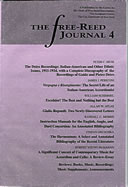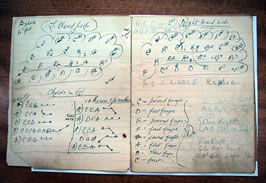 |
|
Instruction Manuals for the English, Anglo, and Duet Concertina: An Annotated Bibliography |
|
|
|
|
Posted 01 April 2003 Instruction Manuals for the English, Anglo, and Duet Concertina: An Annotated Bibliography 1Randall C. Merris
|
| AVAIL | In-print or out-of-print
but still available in the retail market |
| BL | British Library (London)8 |
| CSFRI | Center for the Study of Free-Reed Instruments
(The Graduate Center, The City University of New York) |
| HM | Horniman Museum (London) |
| LC | United States Library of Congress
(Washington, D.C.) |
| ADVERT | Advertised in a music publication
or a dealer catalogue (price list) |
| BMTCC | Board of Music Trade of the United States of America, Complete Catalogue of Sheet Music and Musical Works, 1870 (New York: Da Capo, 1973) |
| EWER | Catalogue of Ewer &
Co.’s Universal Circulating
Music Library (London, 1860) |
| OSS | Other secondary source
(including tutors that I acquired along with old concertinas) |
The sections for English, Anglo, and Duet concertina (including the postscript) contain seventy-four, one hundred and two, and nine entries, respectively. Sixty-one of the English concertina entries originated in the United Kingdom, seven in the United States, two in Ireland, and one each in Holland, Germany, Russia, and Sweden. Forty-nine of the British and three of the American publications for English concertina appeared in the nineteenth century. The earliest entries for the English concertina, dating from 1844 or shortly thereafter, are Instrucción para tocar la Concertina (E30—published in London despite the Spanish title, and nothing more than a translation of E31); Instructions, Followed by a Selection of Melodies and Harmonized Airs (E31); George Case, Exercises for Wheatstone’s Patent Concertina (E11); Ferdinand Pelzer, A Practical Guide to the Concertina (E46); Giulio Regondi, Rudimenti del Concertinista (E52); and Joseph Warren, Warren’s Instructions for the Concertina (E69).
Of the one hundred and two tutors for the Anglo, sixty-nine are from the United Kingdom, twenty-seven from the United States, two from Germany, and one each from Canada, Ireland, Italy, and Sweden. All but twelve of the British publications and all but nine of the American publications appeared in the nineteenth century. The 1846 tutor by Carlo Minasi (A50) and that from circa 1846 by Elias Howe, Jr. (A32) are the earliest British and American publications for Anglo concertina, respectively.
As for the duet concertina, all nine publications are from the United Kingdom, the earliest being Joseph Warren’s 1855 tutor for the “double concertina” (D8).9
The annotations (not included for every item) contain information about authors, publishers, and contents. Choices from among the publications would no doubt have depended on the user’s proficiency, learning style, and musical preferences (classical, folk, etc.). The instructional material tends to be timeless (as witness at least one present-day player of the English concertina who warms up each day with nothing but Regondi, Alsepti, Warren, and Case), except when it deals with such obsolete systems as the 28-key German concertina or the technique of playing the English concertina with four fingers of each hand (though the latter can still be a useful exercise, and at least two concertinists—Douglas Rogers and Wim Wakker—have revived the technique). Many of the tunes and ballads in some of the publications, popular music from a bygone era, have mercifully passed into obscurity.
Most Anglo concertina tutors were written with both standard musical notation and tablature. The tablature was used mainly to overcome musical illiteracy, not to indicate specific fingerings, since many passages contain notes for which there are alternative fingerings. Instruction manuals for English and duet concertina, on the other hand, have little, if any, tablature and have, therefore, been suited mainly to those who can read music. Recently, however, tutors for the Anglo concertina have moved away from tablature, and four of the five most recent Anglo concertina tutors are written in standard musical notation with little, if any, accompanying tablature. These include Mick Bramich’s 1996 tutor, The Irish Concertina: A Tutor for the Anglo Concertina in the Irish Style (A7); Frank Edgley’s 2001 tutor, The Anglo Concertina: Handbook of Tunes and Methods for Irish Traditional Music (A24); Niall Vallely’s 2002 tutor, Concertina CD ROM Tutorial (A87); and the booklet accompanying John Williams’s 1995 video, Learn to Play Irish Concertina (A93). The exception is Mick Bramich’s 2000 tutor, Absolute Beginners’ Concertina (A6), which is written in tablature only and, unlike the others, has no audio or video component.
English concertina instruction has fared less well in the video and digital-audio age. Until recently, the only English concertina tutors with accompanying audio were Alistair Anderson’s 1974 tutor, Concertina Workshop (E2), and Richard Carlin’s 1977 tutor, English Concertina (E8). Anderson’s tutor is currently marketed without the companion LP recording, and Carlin’s tutor, which contained a floppy vinyl record, is out-of-print. The first English concertina tutor with accompanying CD—Pauline de Snoo, Concertina Course, Volume One (E73)—appeared in 2002. The first video or CD-ROM for English concertina instruction has yet to be produced.
The Bibliography
Go to Part I. English Concertina
Go to Part II. Anglo Concertina
Go to Part III. Duet Concertina
Notes
1 Allan Atlas, Robert Gaskins, Douglas Rogers, Neil Wayne, and Leslie (Wes) Williams provided many useful comments on an early draft of this article. Robert Gaskins also uncovered several publications cited herein and helped with research at the British Library and the Horniman Museum. Assistance was provided by staff of the British Library, British Patent Office, Heritage Centre of the Salvation Army, Horniman Museum, and United States Library of Congress; citations were provided by Eric Matusewitch, Göran Rahm, and Gordon Taylor. The genealogical information for the Chidley family was compiled by Paul Udloff, great-grandson of Edward Childey, Sr., and was provided to me by Wes Williams. [ Back to text ]
2 There are actually 185 entries, including five items in the postscript and two tutors that were written for both English and Anglo concertina and which are listed in both sections of the bibliography. For descriptions of the concertina systems, see Allan W. Atlas, The Wheatstone English Concertina in Victorian England (Oxford: Clarendon Press, 1996), 12-15. [ Back to text ]
3 The exceptions are one Canadian tutor (A24), one Dutch tutor (E73), three German tutors (E50, A53, and A101), one Russian tutor (E53), two Swedish tutors (E33 and A45), one tutor published in both Ireland and England (E51), two tutors from Ireland (A87) and (E74), two videos (A85 and A93), and one instruction manual available on the internet (D1). Articles in concertina magazines and newsletters, as well as internet commentaries on how to play the concertina, are excluded. Nor have I included the many English and Anglo concertina “tune books” and “song books,” titled as such, that contain short prefaces on how to hold the instrument, how to use the bellows and keys, etc., even though some of these contain about as much instructional material as some of the instruction manuals included. [ Back to text ]
4 Titles beginning with The are alphabetized by the succeeding word; citations beginning with Robert Cocks and Henry Russell’s are alphabetized under Cocks and Russell’s. A chronological arrangement would have been too imprecise at times. [ Back to text ]
5 These large, square-ended relatives of the Anglo concertina are not covered in the bibliography. For information about them, see Maria Dunkel, Bandonion und Konzertina: Ein Beitrag zur Darstellung des Instrumententyps. Berliner musikwissenschaftlicher Arbeiten 30 (Munich and Salzburg, 1987: Emil Katzbichler, 1987/2nd ed., 1996); Dunkel, Akkordeon, Bandonion, Concertina im Kontext der Harmonikainstrumente. Texte zur Geschichte und Gergenwart des Akkordeons 6 (Bochum: Augemus, 1999); Loren C. Schaeffer, “Chemnitzer Concertina Information” http://www.newulmtel.net/~lorens; and Christian Mensing, “Christian’s Bandoneon Page” http://www.inorg.chem.ethz.ch/tango/band/bandoneon.html, which includes a section on bandoneon tutors. [ Back to text ]
6 See Donald W. Krummel, Guide For Dating Early Published Music (Hackensack, NJ: Joseph Boonin, 1974). [ Back to text ]
7 John A. Parkinson, Victorian Music Publishers: An Annotated List (Warren, MI: Harmonie Park Press, 1990), is an especially useful source. The retail prices shown on the covers of publications provide only weak clues for dating them, since the range of price quotations within and across periods is fairly broad. [ Back to text ]
8 I used the British Library Public Catalogue in the British Library at http://blpc.bl.uk, and The Catalogue of Printed Music in the British Library to 1980 (London: K. G. Saur, 1986), which is now available on CD-ROM: Catalogue of Printed Music in the British Library Plus, 2nd ed. (London: Bowker, 1997). [ Back to text ]
9 I have found no instruction manuals for the Jeffries or Hayden systems of duet concertina. Two of Charles Jeffries’s sons, Charles Jr. and Thomas, produced some handwritten materials (mainly chord diagrams) for their students.
Hayden has produced typescript material for his concertina workshops. On the Hayden system, see Brian Hayden, “The Hayden System,” Concertina Magazine 8 (Autumn 1984): 4-8; on the Jeffries system, see Phil Inglis, “History of the Duet Concertina: Part III,” Concertina Magazine 14 (Spring 1986): 12. [ Back to text ]
Postscript
After this article went to press, five additional instruction manuals were found:
English Concertina
Anglo Concertina
Postscript 2
Postscript 2: After this article was published, the following new editions and new tutors were found.
Anglo Concertina
Postscript 2003
Since this article was posted online in 2002, additional instruction manuals have appeared:
English Concertina
Anglo Concertina
Edgley, Frank C. Irish Traditional Melodies: Irish Session Tune Book. Windsor, Ontario (CA): F. Edgley (with companion CDs, Volumes 1 and 2). AVAIL (at http://www.concertinas.ca)
Postscript 2004
Since this article was last updated in 2003, additional instruction manuals have appeared:
English Concertina
Anglo Concertina
Postscript 2005
Since this article was last updated in 2004, additional instruction manuals have appeared:
English Concertina
Anglo Concertina
Duet Concertina
Author
Randall C. Merris ( ) is an economist at the International Monetary Fund and an amateur Anglo concertinist. He has been an economist at the Federal Reserve Bank of Chicago; has taught economics and finance in the Kellogg Graduate School of Management, Northwestern University; and has consulted with Asian governments on economic policy and financial reform. He writes mainly on economics and occasionally on the concertina and its history.
Have feedback on this article? Send it to the author.
Reprinted from the Concertina Library
http://www.concertina.com
© Copyright 2000– by Randall C. Merris

for English Concertina
Lachenal, c. 1895
Contents
- Instruction Manuals for the English, Anglo, and Duet Concertina: An Annotated Bibliography
- Introduction
- Part I. English Concertina
- Part II. Anglo Concertina
- Part III. Duet Concertina
The original version of this article appeared in The Free-Reed Journal, Vol. 4 (2002), pp. 85-118. © 2002 Randall C. Merris.
- Original
publication

of this article in PDF format - Other articles
by Randall C. Merris
Send this page to a friend.
This page was last changed | |
|
© Copyright 2000– by Robert Gaskins |
